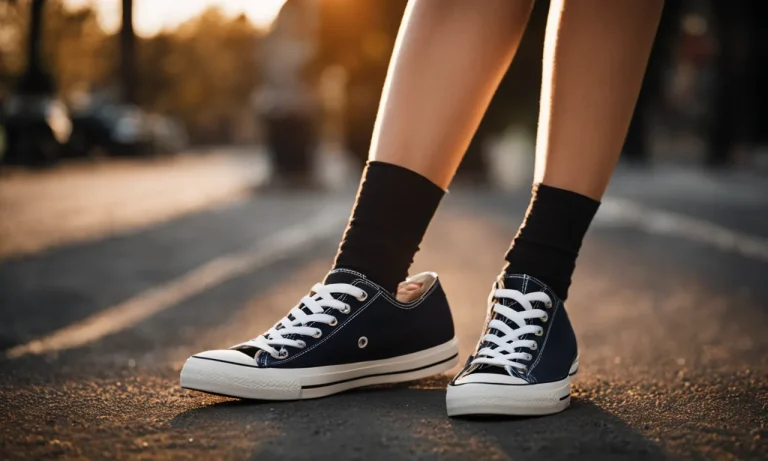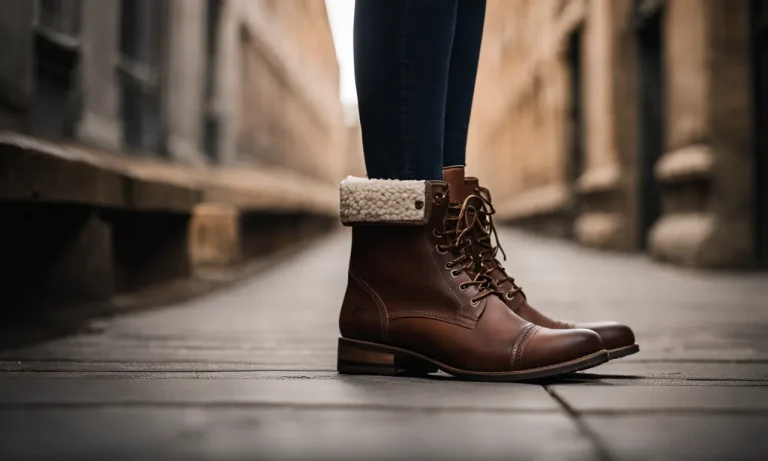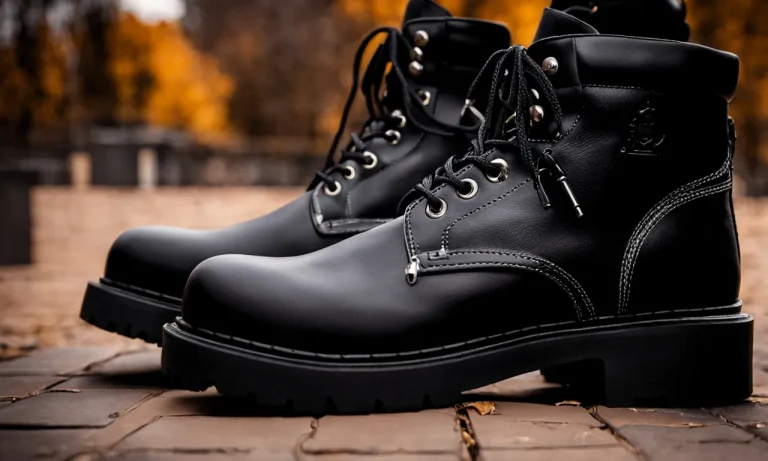Having shoes that are too big can be annoying and uncomfortable. The shoes slip off your feet as you walk, rubbing against your heels and creating blisters. Rather than getting rid of ill-fitting shoes, you can make them work for you with the right inserts.
If you’re short on time, here’s a quick answer to your question: You can make shoes that are too big fit better by using foot cushions, heel grips, or custom orthotic inserts tailored to your foot size and shape.
In this comprehensive guide, we’ll cover everything you need to know about using shoe inserts to improve the fit of shoes that are too large. We’ll discuss the pros and cons of different insert materials and types.
You’ll also learn how to measure your feet properly and choose inserts tailored to your needs. With the right inserts, you can make those roomy shoes fit like a glove.
Why Do Some Shoes End Up Too Big?
It can be frustrating when you purchase a pair of shoes only to find out that they are too big for your feet. There are several reasons why this can happen, and understanding these reasons can help you find a solution to make your shoes fit better.
Sizing Inconsistencies Between Brands
One common reason why shoes can end up being too big is due to sizing inconsistencies between different brands. Each brand may have its own unique sizing system, and what may be a perfect fit in one brand could end up being too big or too small in another.
This is why it’s important to always try on shoes before making a purchase, especially if you are trying out a new brand for the first time.
Feet Changing Size Over Time
Another reason why shoes may end up being too big is that your feet can change size over time. Factors such as weight gain or loss, pregnancy, or even aging can cause your feet to become larger or smaller.
It’s important to regularly measure your feet to ensure that you are wearing the correct shoe size. If you find that your shoes are suddenly too big, it may be time to get re-measured and invest in a new pair that fits properly.
Buying Shoes Online Without Trying Them On
With the rise of online shopping, it has become easier than ever to purchase shoes without trying them on beforehand. While this convenience is great, it also comes with the risk of ending up with shoes that are too big.
When buying shoes online, it’s important to carefully read the sizing information provided by the retailer and compare it to your own measurements. If in doubt, consider ordering multiple sizes and returning the ones that don’t fit properly.
Picking a Larger Size for Comfort
Sometimes, individuals intentionally pick a larger shoe size for added comfort. While this can provide some immediate relief, it often leads to shoes that are too big and don’t provide the necessary support. It’s important to strike a balance between comfort and proper fit.
Consider using shoe inserts or insoles to fill up the extra space and provide a snug fit without compromising on comfort.
Pros and Cons of Different Insert Materials
Foam
Foam inserts are a popular choice for making shoes that are too big fit better. They provide cushioning and support, making them comfortable to wear for extended periods of time. Foam inserts are also lightweight and breathable, allowing air to circulate and keeping your feet cool and dry.
However, foam inserts may wear out more quickly compared to other materials, especially if you frequently wear the shoes.
Gel
Gel inserts are known for their excellent shock absorption properties. They provide superior cushioning and can help alleviate foot pain caused by wearing shoes that are too big. Gel inserts are also durable and can withstand frequent use without losing their shape.
However, gel inserts may be a bit bulkier compared to other materials, which could affect the fit of your shoes, especially if they are already tight.
Cork
Cork inserts are a natural and eco-friendly option for improving the fit of shoes that are too big. They mold to the shape of your feet over time, providing customized support and cushioning. Cork inserts also have antimicrobial properties, which help prevent odors and bacterial growth.
However, cork inserts may not be as soft or cushioned as foam or gel inserts, so they may not be suitable for individuals with specific foot conditions or who require extra comfort.
Leather
Leather inserts are a classic choice for improving the fit of shoes. They are durable and can provide additional support and stability. Leather inserts also have moisture-wicking properties, helping to keep your feet dry.
However, leather inserts may not offer as much cushioning as other materials, so they may not be ideal for individuals who require extra comfort or padding.
Silicone
Silicone inserts are flexible, soft, and provide excellent shock absorption. They can help fill the extra space in shoes that are too big, providing a more secure and comfortable fit. Silicone inserts are also easy to clean and maintain.
However, silicone inserts may not be as breathable as other materials, which could lead to sweaty feet. They may also be more expensive compared to other insert options.
It’s important to consider your individual needs and preferences when choosing the right insert material for your shoes. Experimenting with different materials can help you find the perfect fit and improve the overall comfort of your footwear.
Types of Shoe Inserts for Oversized Shoes
When you find a pair of shoes that you absolutely love but they are just a tad too big, don’t fret! There are various types of shoe inserts that can help you achieve a better fit and keep your feet comfortable throughout the day. Here are some popular options:
Heel Grips
If your oversized shoes tend to slip off at the back, heel grips can be a lifesaver. These small adhesive pads are placed inside the back of the shoe, preventing your feet from sliding forward and improving the fit.
They provide an extra grip to help keep your heels in place, ensuring a more secure and comfortable fit.
Heel Cushions
For those who experience discomfort or pain in the heel area due to oversized shoes, heel cushions can provide relief. These inserts are typically made from cushioning materials like foam or gel and are designed to absorb shock and reduce pressure on the heels.
By adding extra padding to the heel, they can improve overall comfort and prevent blisters or soreness.
Full-Length Insoles
If your entire foot feels loose inside the shoe, full-length insoles can offer a solution. These inserts provide support and cushioning to the entire foot, filling up the extra space and improving the fit.
They are available in various materials and thicknesses, allowing you to choose the level of support and comfort that suits your needs.
Custom Orthotics
If you have specific foot conditions or require specialized support, custom orthotics may be the best option for you. These inserts are custom-made to fit your feet perfectly and address any specific issues you may have.
While they can be more expensive than other types of inserts, they are highly effective in providing personalized support and improving the fit of oversized shoes.
Remember, finding the right shoe insert may require some trial and error. It’s important to consider your specific needs and preferences when choosing the type of insert that will work best for you. Don’t let oversized shoes hold you back from enjoying your favorite footwear – with the right inserts, you can make them fit like a dream!
Tips for Measuring Feet and Choosing Inserts
When it comes to making shoes that are too big fit better, inserts can be a game-changer. They provide additional cushioning, support, and stability to ensure a comfortable fit. However, it is essential to measure your feet correctly and choose the right inserts to maximize their effectiveness.
Trace Your Feet on Paper
One of the simplest ways to measure your feet is by tracing them on a piece of paper. Place the paper on a hard surface and stand on it with your weight evenly distributed. Use a pen or pencil to trace the outline of your foot, ensuring that the pen is perpendicular to the paper.
Repeat the process for both feet and measure the length from the heel to the longest toe. This measurement will help you determine the correct insert size.
Get Professionally Fitted for Custom Orthotics
If you have specific foot conditions or require more advanced support, it may be worthwhile to invest in custom orthotics. A podiatrist or orthopedic specialist can assess your feet and create inserts tailored to your individual needs.
These custom-made inserts provide optimal support and can alleviate common foot problems such as plantar fasciitis, flat feet, or high arches.
Consider Your Foot Type and Common Issues
Everyone’s feet are unique, and understanding your foot type can help you select the most suitable inserts. For example, individuals with high arches may benefit from inserts with more arch support, while those with flat feet may require inserts that provide additional cushioning.
It’s also essential to consider any specific foot issues you may have, such as bunions or heel pain, and choose inserts that address these concerns.
Match Insert Thickness to Shoe Size
When choosing inserts, it’s crucial to consider the thickness and size to ensure a proper fit. Inserts that are too thick can make your shoes feel cramped, while inserts that are too thin may not provide the necessary support.
Check the packaging or product description for guidance on which shoe size the inserts are designed to fit. It’s a good idea to try on the shoes with the inserts to ensure a comfortable fit before making a purchase.
Look for Anti-Slip Features
Another important factor to consider when choosing inserts is their anti-slip features. Inserts with a non-slip surface or adhesive backing can help prevent them from shifting or sliding inside your shoes.
This feature is particularly beneficial if you plan to use the inserts for high-impact activities or sports. Look for inserts that specifically mention anti-slip properties to ensure a secure fit.
Remember, finding the right inserts for your shoes may require some trial and error. Don’t be discouraged if the first pair you try doesn’t provide the desired fit. Keep experimenting with different types, thicknesses, and sizes until you find the inserts that make your shoes feel like they were made just for you.
How to Insert the Inserts and Test for Fit
When it comes to making shoes that are too big fit better, inserts can be a game-changer. Inserts provide extra cushioning and support, making your shoes more comfortable and secure. But how do you insert the inserts and test for fit? Here are some simple steps to follow:
Insert on Top of Existing Footbed
The first step is to place the inserts on top of the existing footbed of your shoes. This will help fill in the extra space and provide additional support. Make sure the inserts are positioned correctly and cover the areas where your feet need the most cushioning or support.
Pro tip: Consider using gel or foam inserts for maximum comfort and shock absorption. Gel inserts are great for reducing pressure on the balls of your feet, while foam inserts provide excellent arch support.
Trim Inserts If Needed
If the inserts are too big for your shoes, don’t worry! You can easily trim them to the right size. Use a pair of scissors to carefully cut the inserts along the designated lines or trim them to fit the shape of your shoes.
Just make sure to follow the manufacturer’s instructions to avoid damaging the inserts.
Did you know? Some shoe stores or specialty shops offer custom-made inserts that are specifically designed to fit your shoes perfectly. These inserts are made based on the measurements of your feet, ensuring a personalized fit and maximum comfort.
Walk with Inserts Before Wearing All Day
Once you have inserted the inserts, it’s important to test them out before wearing your shoes all day. Take a few steps and pay attention to how your feet feel. Are the inserts providing the desired comfort and support? Do they make your shoes fit better?
If not, you may need to adjust or try different inserts.
Pro tip: Walk on different surfaces and inclines to get a better feel for how the inserts affect your overall comfort and stability. This will help you determine if any additional adjustments are needed.
Adjust Based on Comfort and Fit
Lastly, adjust the inserts based on your comfort and fit. If the inserts feel too bulky or tight, you can try removing them or using thinner inserts. On the other hand, if you still feel like your shoes are too big even with the inserts, consider adding additional padding or trying a different type of insert.
Remember: The goal is to find the right balance between comfort and fit. It may take some trial and error to find the perfect combination, so be patient and keep experimenting until you achieve the desired results.
For more information on shoe inserts and how to make shoes that are too big fit better, you can visit






